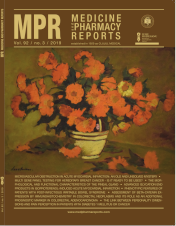The link between personality dimensions and pain perception in patients with diabetes mellitus or cancer
DOI:
https://doi.org/10.15386/mpr-1300Keywords:
personality, TCI, pain, diabetes, cancerAbstract
Background and aims. Diabetes mellitus and cancer are two diseases with a strong psychological impact. Personality traits modulate the perception of pain and the response to disease. The specificity of this study consists of the assessment of personality, pain and emotional impact in the two diseases.
Method. The study included 130 participants assigned to 3 groups: patients with diabetes mellitus, patients with cancer disease, and a control group. The personality traits of all the participants were analyzed using Cloninger’s Temperament and Character Inventory (TCI). For the evaluation of pain, as well as associated anxiety and depression in the diabetes and cancer groups, the Brief Pain Inventory (BPI) and the Hospital Anxiety and Depression Scale (HADS) were used.
Results. Patients with diabetes mellitus and cancer disease had significantly higher total values on the Harm Avoidance scale (HA) (p<0.001) and lower total values on the Self-Directedness scale (SD), Reward Dependence scale (RD), Cooperativeness scale (CO) (p<0.001) compared to the control group. Major anxiety was predominant in patients with diabetes mellitus (34%), and major depression was prevalent in cancer patients (17.5%). Patients with diabetes mellitus obtained a significantly higher severity score at BPI scale than patients with cancer disease (p=0.03).
Conclusions. The existence of a mutual personality profile featuring high levels of Harm Avoidance and low levels of Self-Directedness in patients with diabetes mellitus and cancer who experience pain has great implications for the therapeutic approach. A potential future avenue of management in these diseases may lie in targeting particular personality aspects of chronic pain patients.
Downloads
Published
How to Cite
Issue
Section
License
The authors are required to transfer the copyright of the published paper to the journal. This is done by agreeing to sign the Copyright Assignment Form. Whenever the case, authors are also required to send permissions to reproduce material (such as illustrations) from the copyright holder.

The papers published in the journal are licensed under a Creative Commons Attribution-NonCommercial-NoDerivatives 4.0 International License.

